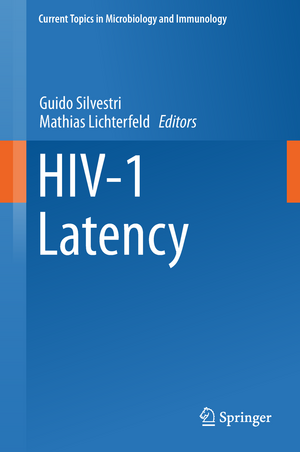HIV-1 Latency: Current Topics in Microbiology and Immunology, cartea 417
Editat de Guido Silvestri, Mathias Lichterfelden Limba Engleză Hardback – 25 oct 2018
| Toate formatele și edițiile | Preț | Express |
|---|---|---|
| Paperback (1) | 713.70 lei 6-8 săpt. | |
| Springer International Publishing – 10 dec 2019 | 713.70 lei 6-8 săpt. | |
| Hardback (1) | 1036.12 lei 6-8 săpt. | |
| Springer International Publishing – 25 oct 2018 | 1036.12 lei 6-8 săpt. |
Din seria Current Topics in Microbiology and Immunology
- 18%
 Preț: 962.03 lei
Preț: 962.03 lei - 5%
 Preț: 1123.13 lei
Preț: 1123.13 lei - 5%
 Preț: 1085.95 lei
Preț: 1085.95 lei -
 Preț: 499.77 lei
Preț: 499.77 lei - 5%
 Preț: 967.81 lei
Preț: 967.81 lei - 18%
 Preț: 1118.62 lei
Preț: 1118.62 lei - 5%
 Preț: 717.00 lei
Preț: 717.00 lei - 5%
 Preț: 712.97 lei
Preț: 712.97 lei - 5%
 Preț: 709.51 lei
Preț: 709.51 lei - 5%
 Preț: 709.51 lei
Preț: 709.51 lei - 5%
 Preț: 721.19 lei
Preț: 721.19 lei - 5%
 Preț: 359.78 lei
Preț: 359.78 lei - 5%
 Preț: 711.88 lei
Preț: 711.88 lei - 5%
 Preț: 774.81 lei
Preț: 774.81 lei - 15%
 Preț: 640.06 lei
Preț: 640.06 lei - 5%
 Preț: 717.00 lei
Preț: 717.00 lei - 5%
 Preț: 360.34 lei
Preț: 360.34 lei - 5%
 Preț: 707.69 lei
Preț: 707.69 lei - 5%
 Preț: 717.56 lei
Preț: 717.56 lei - 5%
 Preț: 716.28 lei
Preț: 716.28 lei - 5%
 Preț: 717.20 lei
Preț: 717.20 lei - 5%
 Preț: 711.32 lei
Preț: 711.32 lei - 5%
 Preț: 711.88 lei
Preț: 711.88 lei - 5%
 Preț: 718.29 lei
Preț: 718.29 lei - 5%
 Preț: 709.51 lei
Preț: 709.51 lei - 5%
 Preț: 369.84 lei
Preț: 369.84 lei - 5%
 Preț: 712.25 lei
Preț: 712.25 lei - 5%
 Preț: 716.45 lei
Preț: 716.45 lei - 5%
 Preț: 706.60 lei
Preț: 706.60 lei - 5%
 Preț: 711.52 lei
Preț: 711.52 lei - 5%
 Preț: 713.54 lei
Preț: 713.54 lei - 5%
 Preț: 720.47 lei
Preț: 720.47 lei - 5%
 Preț: 725.42 lei
Preț: 725.42 lei - 5%
 Preț: 708.06 lei
Preț: 708.06 lei - 5%
 Preț: 713.70 lei
Preț: 713.70 lei - 5%
 Preț: 705.83 lei
Preț: 705.83 lei - 5%
 Preț: 710.96 lei
Preț: 710.96 lei - 5%
 Preț: 723.93 lei
Preț: 723.93 lei - 5%
 Preț: 707.69 lei
Preț: 707.69 lei - 5%
 Preț: 715.35 lei
Preț: 715.35 lei - 5%
 Preț: 709.87 lei
Preț: 709.87 lei - 5%
 Preț: 359.05 lei
Preț: 359.05 lei - 5%
 Preț: 374.20 lei
Preț: 374.20 lei - 15%
 Preț: 635.31 lei
Preț: 635.31 lei - 5%
 Preț: 707.86 lei
Preț: 707.86 lei - 5%
 Preț: 721.96 lei
Preț: 721.96 lei - 15%
 Preț: 632.88 lei
Preț: 632.88 lei - 15%
 Preț: 632.05 lei
Preț: 632.05 lei - 15%
 Preț: 642.83 lei
Preț: 642.83 lei
Preț: 1036.12 lei
Preț vechi: 1090.66 lei
-5% Nou
Puncte Express: 1554
Preț estimativ în valută:
198.29€ • 206.25$ • 163.70£
198.29€ • 206.25$ • 163.70£
Carte tipărită la comandă
Livrare economică 14-28 aprilie
Preluare comenzi: 021 569.72.76
Specificații
ISBN-13: 9783030028152
ISBN-10: 3030028151
Pagini: 250
Ilustrații: VII, 248 p.
Dimensiuni: 155 x 235 x 20 mm
Greutate: 0.54 kg
Ediția:1st ed. 2018
Editura: Springer International Publishing
Colecția Springer
Seria Current Topics in Microbiology and Immunology
Locul publicării:Cham, Switzerland
ISBN-10: 3030028151
Pagini: 250
Ilustrații: VII, 248 p.
Dimensiuni: 155 x 235 x 20 mm
Greutate: 0.54 kg
Ediția:1st ed. 2018
Editura: Springer International Publishing
Colecția Springer
Seria Current Topics in Microbiology and Immunology
Locul publicării:Cham, Switzerland
Cuprins
Molecular Control of HIV and SIV Latency.- Assays to Measure Latency, Reservoirs and Reactivation.- The Antiviral Immune Response and its Impact on the HIV-1 Reservoir.- Nonhuman Primate Models for Studies of AIDS Virus Persistence During Suppressive Combination Antiretroviral Therapy.- SIV Latency in Macrophages in the CNS.- Mathematical models of HIV latency.- Residual Immune Activation and Latency.- Immune Interventions to Eliminate the HIV Reservoir.- Cell and Gene Therapy for HIV Cure.
Notă biografică
Guido Silvestri
Emory University School of Medicine, Atlanta, GA 30329, USA
gsilves@emory.edu
Emory University School of Medicine, Atlanta, GA 30329, USA
gsilves@emory.edu
Mathias Lichterfeld
The Brigham and Women’s Hospital and the Ragon Institute of MGH, MIT and Harvard, Boston, MA, USA
MLICHTERFELD@mgh.harvard.edu
The Brigham and Women’s Hospital and the Ragon Institute of MGH, MIT and Harvard, Boston, MA, USA
MLICHTERFELD@mgh.harvard.edu
Textul de pe ultima copertă
This volume summarizes recent advances in understanding the mechanisms of HIV-1 latency, in characterizing residual viral reservoirs, and in developing targeted interventions to reduce HIV-1 persistence during antiretroviral therapy. Specific chapters address the molecular mechanisms that govern and regulate HIV-1 transcription and latency; assays and technical approaches to quantify viral reservoirs in humans and animal models; the complex interchange between viral reservoirs and the host immune system; computational strategies to model viral reservoir dynamics; and the development of therapeutic approaches that target viral reservoir cells. With contributions from an interdisciplinary group of investigators that cover a broad spectrum of subjects, from molecular virology to proof-of-principle clinical trials, this book is a valuable resource for basic scientists, translational investigators, infectious-disease physicians, individuals living with HIV/AIDS and the general public.
Caracteristici
Offers new insights into the fascinating area of HIV latency and persistence from multiple perspectives and scientific directions Provides in-depth analyses of current concepts, paradigms and ideas that drive the HIV-1 cure agenda Identifies areas that require specific emphasis in future studies
